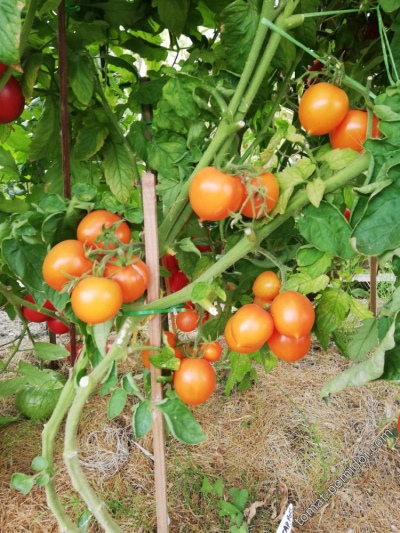
- Authors: Khovrin A.N., Korchagin V.V., Maksimov S.V., Tereshonkova T.A., Klimenko N.N.
- Year of approval: 2018
- Category: grade
- Growth type: determinant
- Appointment: fresh consumption, for whole fruit preservation
- Ripening period: early
- Ripening time, days: 85-95
- Growing conditions: for open ground, for film greenhouses
- Bush size: undersized
- Bush height, cm: up to 50
Tomato Amber placer on any, even unremarkable, area stands out for its bright amber-orange fruits, adding a good, sunny mood. But such spectacular tomatoes are intended not only for beauty, they can be used to prepare a great variety of delicious and original fresh or hot dishes. The variety is versatile - it can be grown both under temporary shelters and outdoors.
Breeding history
The Amber Placer variety is the result of the work of a group of domestic breeders: N. N. Klimenko, A. N. Khovrin, T. A. Tereshonkova, V. V. Korchagin, S. V. Maksimov. agrofirm "Poisk". The variety is included in the State Register of the Russian Federation in 2018. Approved for cultivation both in the open field and under the film in domestic subsidiary farms.
Description of the variety
The described variety is a determinant low-growing plant, reaching a height of no more than half a meter. The standard bush has a small number of medium-sized leaves with a simple green color. Simple inflorescences with articulations are formed on compact branches. Each bunch contains 5-6 ovaries.
The main qualities of the fruit
The fruits of the Amber Placer have a very interesting shape, they are round, but at the same time they resemble a heart, they have a very neat "nose", there is a slight ribbing. Tomatoes are smooth, glossy, medium density, not prone to cracking. Unripe berries are usually green, fully ripe tomatoes are amber-orange in color. There are few nests in fruits - 2-3. The tomatoes themselves are small, their average weight is 55-60 grams.
Taste characteristics
The amber scatter is a typical salad variety, it has an excellent taste, where there are both sweetish notes and a pleasant sourness. Given its size, the variety is ideal for whole-fruit canning. But it is best to eat these vegetables fresh, as they have a beneficial carotenoid composition, which helps to improve vision.
Ripening and fruiting
The described variety is early maturing, from the first shoots to the start of ripening it takes 85-95 days.
Yield
As for the yield of the Amber placer, the recorded figures under the film are 2.8 kg / sq. m.
The timing of planting seedlings and planting in the ground
Like many other varieties, the Amber Placer is grown by seedlings. Plantings must be irrigated with settled water, dive into individual pots at the stage of two leaves that have appeared. It is also recommended to feed the seedlings with "Kemira" or "Strong". As for the sowing dates, they are different in different regions, since the variety is recommended for cultivation throughout the country.

Growing tomato seedlings is an extremely important process, because it largely depends on whether the gardener can harvest at all. All aspects must be taken into account, from seedbed preparation to planting in the ground.
Landing scheme
The optimal scheme for planting tomatoes of the Amber Placer variety in the ground is 5-6 bushes per square meter of the site area. For planting, dig holes up to 30 cm deep.

Growing and care
The amber placer is a compact crop, so caring for such small plants is not difficult. It includes traditional events:
- balanced watering - for each bush, a volume of water of at least 4-6 liters is required;
- fertilizing with mineral and organic fertilizers during flowering and pouring of fruits;
- loosening after watering, subsequent mulching, the mulch layer should be about 7-8 cm.




A plant needs different micronutrients at each stage of growth. All fertilizers can be divided into two groups: mineral and organic. Folk remedies are often used: iodine, yeast, bird droppings, eggshells.
It is important to observe the rate and period of feeding. This also applies to folk remedies and organic fertilizers.


Resistant to adverse weather conditions
Varietal tomato Amber placer can set fruits even under the most unfavorable climatic conditions.
Growing regions
The variety is zoned throughout the territory of Russia, starting from the center, north and north-west of the European part and to the Far East.

























































































